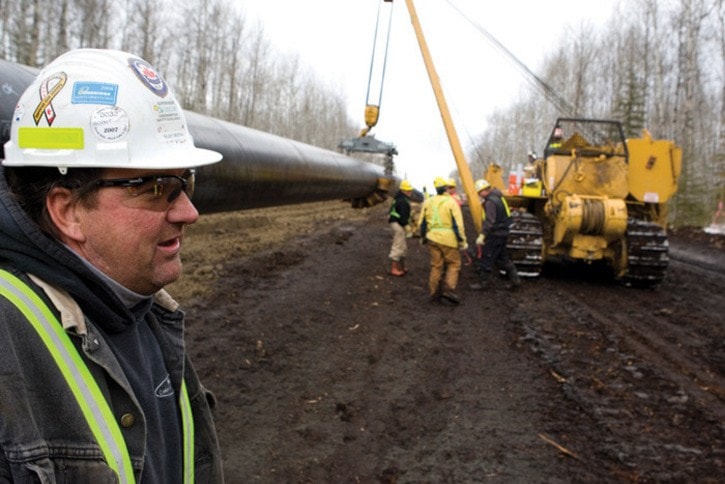Enbridge officials are sharpening their sales pitch for the company’s planned Northern Gateway oil pipeline project, saying it will bring jobs, provide an economic boost and help wean the country from an overdependence on the United States of America.
Andrew Popko, one of three Enbridge officials on a tour of the area last week, said Canada deserved to get world prices for its products.
“Our most valuable asset is oil from northern Alberta,” he said.
Enbridge’s planned $5.5 billion pipeline, which would be the largest private sector project in the province’s history, is to run 1,177 kilometres from Alberta to a marine export terminal at Kitimat.
From there, oil would be shipped to Asian countries needing fuel to continue economic growth.
The project is actually two pipelines, one to transport oil to Kitimat and the other to import a thinning agent called condensate which, when mixed with oil, will make it flow smoother.
“We have the highest environmental standards in the country,” said Popko.
“If anybody is going to do it, it should be us,” he added of pipeline construction.
Enbridge engineering manager Ray Doering said the pipeline would be constructed to meticulous standards. Sensors spaced out along the pipeline’s length would warn officials at a central monitoring station of pipeline pressure fluctuations, a sign of a leak or rupture, he said.
Pumping would be halted and valves closed to isolate sections of the pipeline should there be trouble, Doering added.
He said they’ve already identified the most sensitive environmental areas, like which rivers need more protection.
“I think we’re up over 90 valves on each of these pipelines right now, which is more than any system...I’m aware of by far,” he said, saying that that’s an average of one sensor for every 10 kilometres or so.
“What will likely be the case though, is that in some cases it will be much closer than that; either side of important rivers, either side of important environmental features,” he continued.
“A lot of time goes into...where those valves should be placed to be most effective. In the unlikely event that there’s a leak, and you have to respond, where do you want those valves - that’s step one.”
The second step is a detailed emergency response plan for every water course.
“What if there was a leak and oil got into this water course - where would we respond, where should the equipment be stored, where will the people be, how long will it take them to get there, where do you put booms...at what point do you determine control points?” he said.
But final details can’t be decided until the pipeline’s final route is chosen, Doering said.
Despite rigorous environmental and engineering standards, a third Enbridge official said a demand by those who oppose Northern Gateway that the company guarantee there be no leaks at all is not reasonable.
“The standards that our opponents would like to impose upon us...that’s essentially a promise, the commitment, that there will be no accident, ever, at any time. That there will be no spills, zero spills, for the life of the pipeline,” said Paul Stanway, recently hired to spearhead Enbridge’s public relations efforts surround the Northern Gateway pipeline.
“One hundred per cent, forever? Is that reasonable?” he said.
“If we did that for other industries, you wouldn’t be flying an aircraft, you wouldn’t be driving cars around, we wouldn’t be using electricity. You have to set a reasonable, achievable target here, and that’s what we’re trying to do.”
Stanway said the company has every confidence Northern Gateway will be accepted by the National Energy board, the federal regulator.
“We believe in the regulatory process in this country,” he said.
As for opposition to the project, Stanway said nothing that has happened so far has particularly surprised Enbridge.
“It was to be expected,” said Stanway of protests and other visible signs of opposition.
He also said not every First Nation is opposed to the project.
But Stanway did acknowledge there are First Nations and other groups absolutely against the pipeline plan.
“Some people have a very emotional reaction,” he said.
Generally, people who are already familiar with pipelines, primarily those living east of Prince George, are more willing to accept Northern Gateway, Stanway added.
